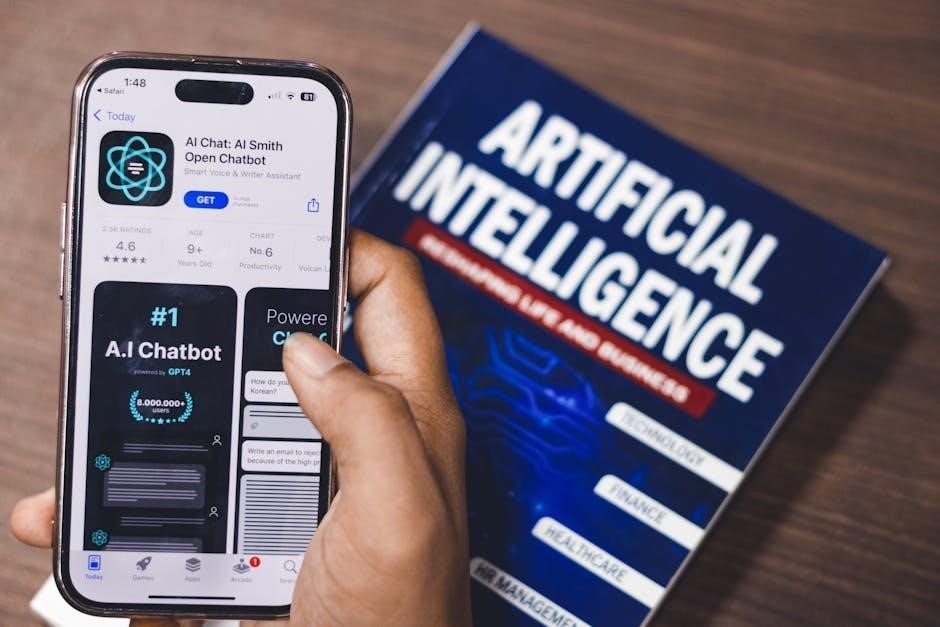This book introduces artificial intelligence with Power BI, enabling data analysts to explore advanced analytics and AI possibilities with their data using Power BI tools and features effectively always․
Overview of Artificial Intelligence in Power BI
The artificial intelligence capabilities in Power BI enable organizations to quickly and easily gain more intelligent insights from unstructured and structured data, using tools such as cognitive services and machine learning․
This allows data analysts to explore advanced analytics and AI possibilities with their data, creating a more informed decision-making process․
With the use of artificial intelligence in Power BI, users can create and consume AI models in their reports, gaining better insights into patterns and trends in their data․
The integration of AI with Power BI provides a range of benefits, including the ability to analyze large datasets, identify relationships and trends, and make predictions about future outcomes․
Using artificial intelligence with Power BI also enables users to automate many tasks, freeing up time for more strategic and creative work․
Overall, the use of artificial intelligence in Power BI has the potential to revolutionize the way organizations approach data analysis and decision-making, enabling them to make more informed and effective decisions․
By leveraging the power of AI, users can unlock new insights and drive business success, making it an essential tool for any organization looking to stay ahead of the curve․
The artificial intelligence capabilities in Power BI are constantly evolving, with new features and tools being added regularly, providing users with even more opportunities to gain insights and drive business success․

Prerequisites for Exploring Artificial Intelligence in Power BI
Users need prior knowledge of Power BI to explore artificial intelligence features and tools effectively always online․
Software and Hardware Requirements for Running Code Files
To run the code files present in the book, users need to have the necessary software and hardware requirements․ This includes having Power BI installed on their system, as well as other tools and features that are required for artificial intelligence and machine learning․ The book provides a list of the required software and hardware, which includes Power BI, R, and Python․ Users can download the required software and tools from the official websites, and install them on their system․ The hardware requirements include having a computer with a decent processor, memory, and storage․ The book also provides links to the documentation and demos for each feature, which can be accessed online․ By having the necessary software and hardware requirements, users can run the code files and explore the artificial intelligence features in Power BI effectively․ The requirements are listed in the book, and users can refer to them to ensure that they have the necessary tools and features to run the code files․
Self-Service AI Features in Power BI Desktop
Power BI Desktop offers various self-service AI features, including question and answer, insights, and what-if parameters, for data analysis and visualization purposes always online effectively․
Question and Answer, Insights, and What-If Parameters in Power BI
Power BI offers various features such as question and answer, insights, and what-if parameters to facilitate data analysis and visualization․ The question and answer feature allows users to ask natural language questions and receive answers in the form of visualizations․ Insights provide users with a deeper understanding of their data by automatically detecting patterns and trends․ What-if parameters enable users to create interactive models that allow them to explore different scenarios and predict outcomes․ These features are designed to work together to provide a comprehensive and intuitive data analysis experience․ By using these features, users can gain a better understanding of their data and make more informed decisions․ The integration of these features into Power BI has made it a powerful tool for data analysis and visualization, and has enabled users to unlock new insights and perspectives from their data․ Power BI is a popular choice among data analysts and business intelligence professionals․

Integration with Cognitive Services and Azure Machine Learning
Power BI integrates with Cognitive Services and Azure Machine Learning for advanced analytics and machine learning capabilities always online․
Using R and Python in Power BI for Advanced Analytics
Power BI supports the use of R and Python scripts for advanced analytics, allowing users to create custom visuals and models․ The Power BI interface provides an easy-to-use editor for writing and executing R and Python code․ This enables data analysts to leverage the power of these programming languages to gain deeper insights into their data․ With the ability to integrate R and Python scripts, users can perform advanced data manipulation, create predictive models, and visualize complex data sets․ The use of R and Python in Power BI also enables the creation of custom machine learning models, which can be used to forecast future trends and make predictions․ By leveraging the power of R and Python, users can unlock new possibilities for data analysis and visualization in Power BI, and gain a deeper understanding of their data․ This feature is a key component of Power BI’s advanced analytics capabilities․

Creating and Consuming AI Models in Power BI Reports
Users can create and consume AI models in Power BI reports using tools and features to gain insights effectively always online․
Enriching Data and Gaining Better Insights with AI Techniques
Artificial intelligence techniques can be used to enrich data and gain better insights in Power BI․ By applying AI techniques, users can uncover hidden patterns and relationships in their data․ This can be achieved through the use of machine learning algorithms and other advanced analytics tools; The AI techniques can be used to analyze large datasets and identify trends and anomalies․ Additionally, AI can be used to predict future outcomes and make recommendations․ The use of AI techniques in Power BI can help users to make more informed decisions and drive business growth․ With the help of AI, users can gain a deeper understanding of their data and make more accurate predictions․ The AI techniques can be used in various industries, including finance, healthcare, and retail․ By using AI techniques, users can unlock the full potential of their data and gain better insights․ The use of AI in Power BI is a powerful tool for data analysis and can help users to achieve their goals․

Official GitHub Repository for Artificial Intelligence with Microsoft Power BI
The official GitHub repository for Artificial Intelligence with Microsoft Power BI provides a comprehensive collection of resources and tools for developers and data analysts․ The repository includes sample code and tutorials on how to use AI and machine learning in Power BI․ Users can access the repository to learn more about the AI features and capabilities in Power BI․ The repository is regularly updated with new content and features, making it a valuable resource for anyone working with Power BI and AI․ The GitHub repository is also a community-driven platform, where users can share their own projects and collaborate with others․ By accessing the repository, users can stay up-to-date with the latest developments in AI and Power BI, and learn from the experiences of others․ The repository is a valuable resource for anyone looking to get started with AI in Power BI, or to take their skills to the next level․